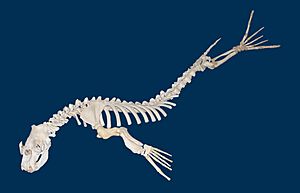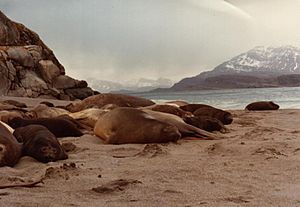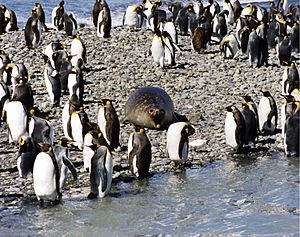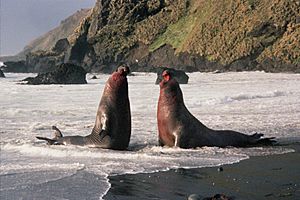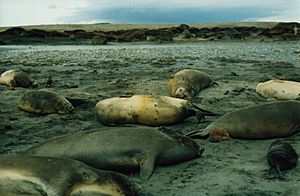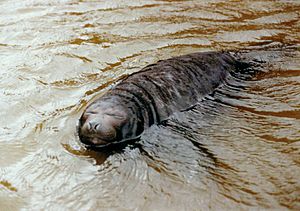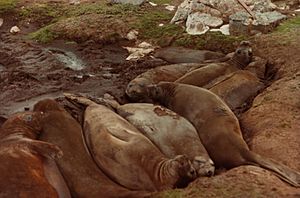Southern elephant seal facts for kids
The southern elephant seal (Mirounga leonina) is one of the two types of elephant seals. It is the biggest seal in the world and the largest carnivore on Earth that lives in the ocean but isn't a whale or dolphin. These seals get their name from their huge size and the large nose, called a proboscis, that adult males have. This special nose helps them make very loud roars, especially when they are looking for a mate.
A male southern elephant seal is much heavier than a male northern elephant seal. It's also more than twice as heavy as a male walrus and much, much heavier than the biggest land carnivores like the polar bear or Kodiak bear.
Quick facts for kids Southern elephant sealTemporal range: Pleistocene-recent
|
|
|---|---|
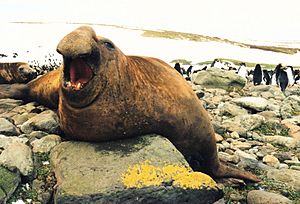 |
|
| Male (bull) | |
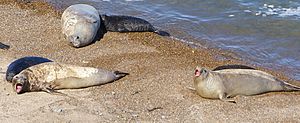 |
|
| Females (cows) and pups | |
| Conservation status | |
| Scientific classification | |
| Genus: |
Mirounga
|
| Species: |
leonina
|
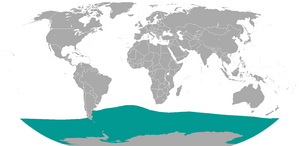 |
|
| Southern elephant seal range | |
| Synonyms | |
|
Phoca leonina Linnaeus, 1758 |
|
Contents
Seal Classification: Taxonomy
The southern elephant seal was first described by a Swedish zoologist named Carl Linnaeus in 1758. He gave it the scientific name Phoca leonina. Later, in 1827, another scientist named John Edward Gray created the group, or genus, Mirounga, which is where these seals belong today. In the 1800s, people often called this animal the "bottle-nosed seal."
Physical Description
The southern elephant seal is different from the northern elephant seal in a few ways. It is much heavier and has a shorter nose (proboscis). When male southern elephant seals fight, they tend to bend their backs more, making them look taller than their northern cousins.
These seals show the biggest difference in size between males and females of any mammal. Males are usually five to six times heavier than females.
- Female southern elephant seals typically weigh between 400 to 900 kilograms (880 to 2,000 pounds) and are 2.6 to 3 meters (8.5 to 9.8 feet) long.
- Male seals, called bulls, can weigh from 2,200 to 4,000 kilograms (4,900 to 8,800 pounds) and grow to 4.2 to 5.8 meters (14 to 19 feet) in length.
To give you an idea, in other large marine mammals like the northern elephant seal or sperm whale, males are usually about three times heavier than females. Some very large male southern elephant seals can even be four times heavier than females.
The size of southern elephant seals can also vary depending on where they live. For example, seals from South Georgia are about 30% heavier and 10% longer than those from Macquarie Island. The largest male ever recorded was found in South Georgia in 1913. It was 6.85 meters (22.5 feet) long and was estimated to weigh 5,000 kilograms (11,000 pounds)! The biggest female recorded weighed 1,000 kilograms (2,200 pounds) and was 3.7 meters (12 feet) long.
Southern elephant seals have large, round, black eyes. Their eyes are good at seeing in low light, which helps them find food. Like all seals, their back legs form a tail and tail fin. Each "foot" has five long, webbed toes. They use this strong tail to push themselves through the water. Their front fins, called pectoral fins, are not used much for swimming.
On land, their back legs are not good for walking. Instead, they use their front fins to push their bodies forward. They can move quite fast this way, up to 8 kilometers per hour (5 mph), for short distances. This helps them get back to the water, catch up to a female, or chase away another male.
Baby seals, called pups, are born with black fur. This fur is not good for swimming but keeps them warm in the cold air. When they are ready to stop drinking their mother's milk, they shed this fur. After shedding, their coats can turn grey or brown. Older males often have thick, scarred skin.
Like other seals, elephant seals have a special system in their bodies to stay warm. Small veins wrap around arteries, which helps to keep heat inside their bodies. This is especially important in their flippers and other body parts that get cold easily.
Where Southern Elephant Seals Live
In the mid-1990s, there were about 650,000 southern elephant seals in the world. By 2005, this number grew to between 664,000 and 740,000 animals. Scientists have found three main groups of these seals, each living in a different ocean.
Studies show that elephant seals travel to the edge of the Antarctic continent to find food. While they might come ashore in Antarctica to rest or mate sometimes, they usually gather to breed in warmer places near the Antarctic, called subantarctic islands.
The largest group of seals lives in the South Atlantic Ocean. This group has over 400,000 seals, with about 113,000 breeding females on South Georgia. Other places where this group breeds include the Falkland Islands and Valdes Peninsula in Argentina. The Valdes Peninsula is the only place where they breed on a continent.
The second group lives in the south Indian Ocean and has up to 200,000 seals. Most of these seals breed in the Kerguelen Islands. The rest breed in the Crozet Islands, Marion and Prince Edward Islands, and Heard Island. Some also breed on Amsterdam Island.
The third group, with about 75,000 seals, lives in the subantarctic islands of the Pacific Ocean, south of Tasmania and New Zealand. Most of these seals are found on Macquarie Island.
In the past, there were also colonies in Tasmania, Saint Helena, and the Juan Fernández Islands off the coast of Chile. Sometimes, seals that are shedding their fur have been seen in South Africa or Australia. There have also been rare sightings in places like Mauritius, Ecuador, and Peru.
After a lot of hunting in the 1800s, the southern elephant seal population grew back to a good size by the 1950s. However, since then, the groups in the Indian and Pacific Oceans have mysteriously decreased. The population now seems to be stable, but scientists are still not sure why these changes happened. Some ideas include changes in climate, competition with other animals, or even the way scientists monitor them.
Behavior and Life Cycle
Social Behavior and Reproduction
Elephant seals can stay on land for a long time, sometimes for several weeks in a row each year. Males arrive at the breeding colonies before the females. They fight each other to control groups of females, called harems. Being big helps them win these fights. The strongest males, called "harem masters," get to control dozens of females. Less successful males might try to mate with females when the harem master isn't looking. Many young females and some older ones also mate in the ocean with males that are not part of a harem.
A male seal must stay in his territory to protect it. This means he might go months without eating, living only on the fat stored in his body. When two males fight, they use their weight and sharp teeth. These fights are usually not deadly, and the losing male will run away. However, males can get serious cuts and tears. Some males can stay on land for over three months without food. Males often make a coughing roar sound. This helps other seals recognize them and know how big they are. Fights between high-ranking males are often settled by showing off and roaring, rather than by physical contact.
Baby seals are usually born quickly during the breeding season. After being born, a newborn pup will bark, and its mother will make a high-pitched moan back. The newborn starts to drink its mother's milk right away. This feeding period lasts about 23 days. During this time, the mother does not eat. Newborn pups weigh about 40 kilograms (88 pounds) at birth and grow to about 120 to 130 kilograms (260 to 290 pounds) by the time they stop drinking milk. The mother loses a lot of weight during this period.
Young seals that have stopped drinking milk gather in groups called nurseries until they shed their birth fur. They then go into the water to practice swimming, often starting in calm areas like estuaries or ponds. In the summer, elephant seals come ashore to shed their old skin and fur, a process called moulting. This sometimes happens right after they have reproduced.
Feeding and Diving
Scientists using satellite trackers have found that these seals spend very little time on the surface of the water, usually just a few minutes to breathe. They dive again and again, each time for more than 20 minutes, to hunt for food. They eat squid and fish, diving to depths of 400 to 1,000 meters (1,300 to 3,300 feet). They are the deepest diving animals that breathe air but are not whales or dolphins. One seal was recorded diving to an amazing depth of 2,388 meters (7,835 feet)!
Southern elephant seals are the best divers among all seals in terms of how long, how deep, and how often they dive. In many ways, they are even better than most whales and dolphins. They can do this because their bodies have special ways to store more oxygen and use less oxygen.
In the ocean, these seals seem to live alone. Most females dive in the open ocean to find food, while males dive in both the open ocean and near the seafloor. Each year, seals tend to return to the same areas to hunt. Because their hunting grounds are so deep and hard to reach, scientists don't have all the details about what they eat. However, they have observed some of their hunting behaviors.
When hunting in the dark depths, elephant seals likely use their eyesight to find prey. Some prey animals glow in the dark, which helps the seals see them. Elephant seals don't use echolocation like whales and dolphins do. But their whiskers (vibrissae) on their faces are very sensitive to vibrations, which probably helps them find food.
When they are near the subantarctic or Antarctic coasts, the seals mostly eat deep-sea cephalopods (like squid) and various types of fish. They also eat krill and other small crustaceans, and sometimes even algae.
Predators
Young southern elephant seal pups and juveniles can be hunted by orcas. There have also been cases where leopard seals and New Zealand sea lions have attacked and killed small pups. Great white sharks have hunted elephant seals near Campbell Island. Scientists have also found bite marks from southern sleeper sharks on elephant seals near the Macquarie Islands.
Conservation Efforts
After being hunted almost to extinction in the 1800s, the total population of southern elephant seals grew back to between 664,000 and 740,000 animals by 2005. However, by 2002, two of the three main groups were decreasing in number. The reasons for this are not clear, but scientists think it might be related to where the seals' main food sources are found and if those food sources are decreasing.
Most of the important places where these seals breed are now protected. They are either UNESCO World Heritage Sites or protected by national laws.
Climate Change and Seals
Climate change is having a big impact on ocean animals like southern elephant seals. These seals are top predators in the Southern Ocean, which is one of the areas most affected by fast climate change. Scientists have started projects like "Southern elephant seals as oceanographic samplers" to learn more. In these projects, small devices are attached to the seals to collect information about their behavior and the ocean conditions. This data, collected for over ten years, helps researchers understand how climate change affects southern elephant seals and the Antarctic ecosystem. It shows how the Southern Ocean is changing and how these animals react to those changes.
Southern elephant seals are important for these studies because they dive very deep and eat a lot of food. As predators at the top of the food chain, their health and how well they find food can tell us a lot about the health of the entire Antarctic ecosystem. So, if southern elephant seals are doing well, it often means the whole ecosystem is healthy.
Different groups of southern elephant seals often go to specific ocean areas to find food. They are most successful in areas with certain water conditions, like where deep water rises to the surface in the Antarctic Circumpolar Current. In the Southern Ocean, southern elephant seals are often found near certain ocean currents and zones. However, how well they find food in these areas changes a lot depending on the year, season, and whether the seal is male or female. Some of these changes can be linked to climate changes, like shifts in where these ocean currents are located. Overall, southern elephant seals seem to be able to handle these changes in ocean currents and food availability quite well.
Images for kids
-
A seal resting on land, called hauling-out, in Whakatane, New Zealand
See also
 In Spanish: Elefante marino del sur para niños
In Spanish: Elefante marino del sur para niños



